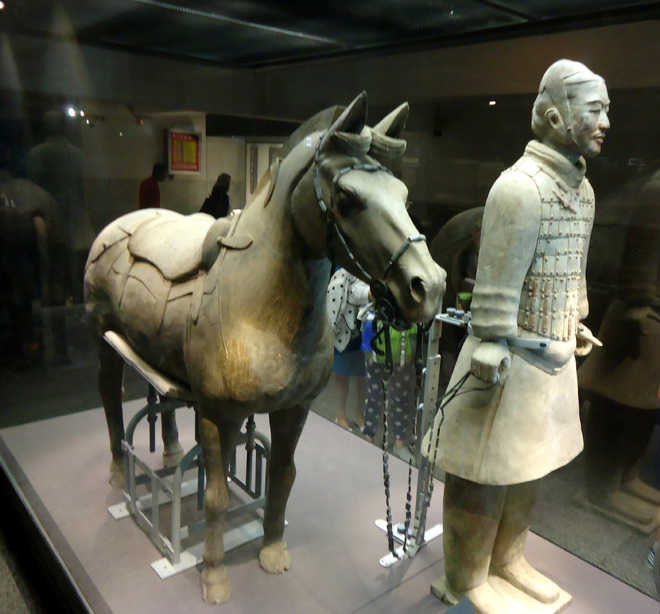
No detail has been neglected in these life-like sculptures of the warriors Photos by the writer
Tanushree Podder
In 1974, at the foot of Lishan Mountain, located in Xi’an in China,a few farmers digging a well stumbled upon a stunning array of terracotta soldiers, horses and chariots. The chance discovery by the farmers catapulted Xian to the top of the list of Unesco World Heritage Sites and the world was gifted one of the greatest archaeological discoveries of the 20th century.
The French President Jacques Chirac called it the 8th wonder of the world. The terracotta sculptures portray the armies of Qin Shi Huang, the first Emperor of China, who is credited with uniting the warring states of his country.
More than 2,000 years ago, Emperor Qin had ordered that an army of terracotta statues be made, so these could be buried with him as the Chinese believe that statues can come alive in the afterlife. His desire to continue ruling after death is given as one of the reasons for the creation of this huge subterranean army of thousands of terracotta warriors.
These life-size warriors, cavalry men, horses, archers, senior officers and generals were positioned in the ancient army order. Amazingly, no two statues matched each other in clothing, facial and hair details. The mausoleum of Emperor Qin Shi Huang is the largest preserved site in China. Its layout echoes the plan of the capital, Xianyang, with the imperial palace enclosed by the walls of the city, which, in turn, are ringed by more walls.
The statues are preserved in three vaults. There is also an exhibition hall of the bronze chariots found underground. Together, these form a priceless collection that represents the cultural and military details of that era.
Pit 1 was opened to the public in 1979. It has nine corridors. With its impressive terracotta figures of soldiers and horses, it is the largest one. In the front stand, three rows of soldiers, armed with long spears, cross and longbows and arrows, daggers or bronze sword. Surprisingly, these weapons are resistant to rust and corrosion. The pit is believed to contain about 7,000 warriors although only 2,000 are currently displayed. Excavations still continue.
Pit 2 and 3 were unearthed in 1976. In Vault two, soldiers stand according to the army’s order of march that existed during the time of Emperor Qin. In the first batch there are rows of archers in kneeling and standing position, the second part has chariots while the third consists of soldiers from infantry, cavalry and also chariots positioned in rectangular manner. At the end stand weapon-brandishing troopers. The hairstyles of soldiers, archers, generals and officials are sculpted in great details. Each of the ranks had a different hairstyle.
Pit 3 is the smallest one of the three vaults with only 72 terracotta figures of warriors and horses. With its array of officials, it represents the command post. Strangely, many of the statues are headless.
Close to the third vault is the exhibition hall with two impressive bronze carriages. These were discovered near the tomb of Emperor Qin in December 1980. Driven by four horses, the carriages are a fine example of the workmanship that existed in Chin, 2000 years ago. Ornamented with several pieces of gold and silver, they are the largest pieces of primeval bronze -ware ever discovered. These together with some of the original weaponry and the statue of a mid-ranking officer are the tour de force of pit 3.
According to Unesco, the site is of prime importance because of hyper realistic sculptures where no detail has been neglected, right from the uniforms of the warriors, their arms, to even the horses' halters.



























